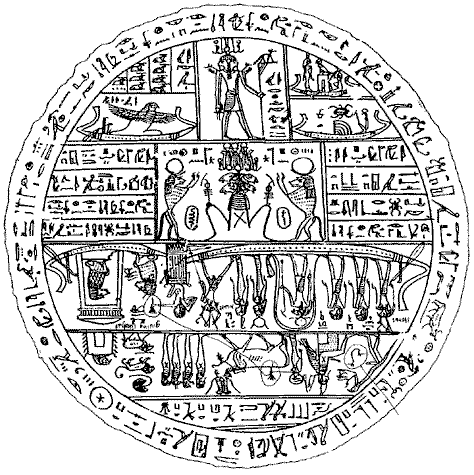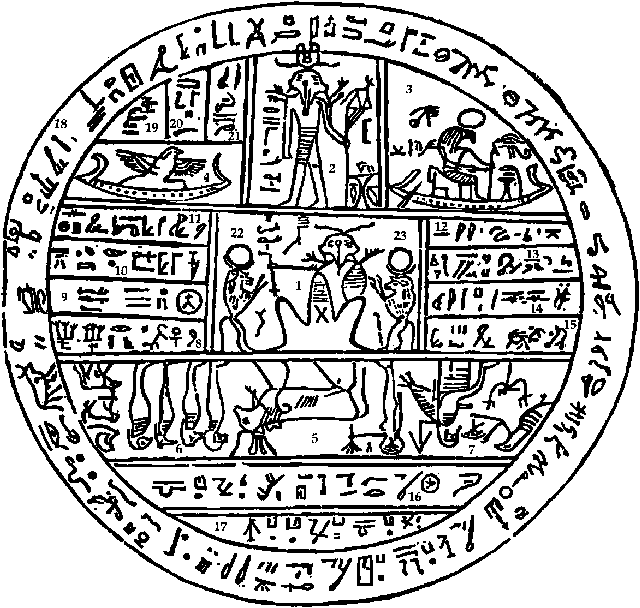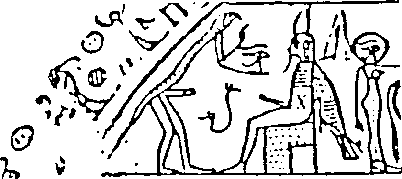 | Book of Abraham Fraud To Mormons, the Pearl of Great Price is one of four books accepted as scripture, on equal holiness and authority with the Bible. To informed Christians, it is pornographic, idolatrous filth that honors pagan idols and disrespects God. One can prove very easily that the Book of Abraham, a part of the Pearl of Great Price, is of Satan. Facsimile 2 of the Book of Abraham is known to Egyptologists as a hypocephalus, an Egyptian funerary amulet. Hundreds of hypocephali are in museums around the world. As a part of pagan burial ritual, the hypocephalus was placed under (hypo) the deceased's head (cephalus) to provide magical light and warmth. The hypocephalus, as a part of pagan burial superstition, has no business representing anything claiming to be "Christian." For comparison purposes, here is a picture of a hypocephalus that was made for Lady Takhred-Khonsu, daughter of Khonsu-ir-dis. It is similar to Joe Smith's Facsimile 2 hypocephalus that was made for a man named Sheshonq:  Below is the Book of Abraham Facsimile 2 hypocephalus. One notes various similar features between it and the Lady Takhred-Khonsu hypocephalus. These similar features in the two hypocephali include the sun god Ra (Fig. 3) on his solar bark; Amon-Re (Fig. 2), the two-headed god with jackal's heads on his shoulders; Thoth's baboons (Figs. 22-23) who have disks on their heads and who stand in the posture of adoration; Khnum (Fig. 1), a ram headed god; the hawk (Fig. 4) with outstretched wings; the four sons of Horus (Fig. 6); the cow goddess Hathor (Fig. 5); Min and Nehebkau (Fig. 7).  In both hypocephali, Min has an erect penis. In the Takhred-Khonsu hypocephalus, both Min and Nehebkau, whom Joe Smith says represents "God" and the "Holy Ghost," face each other with stiff penises. In both hypocephali, Min has his characteristic hawk's tail, beard and lightening bolt flail (in the form of a crooked arrow). In both hypocephali, Nehebkau presents Min with the udjat eye (All-Seeing Eye of Horus). Mormons should look carefully at the two pagan gods facing each other with erect penises, and should decide for themselves if the Figure 7 personages whom Joe Smith says represent the LDS "God" and "Holy Ghost" are the God and Holy Ghost of the Bible, or whether they are a different God and Holy Ghost. If after this examination, people remain in Mormonism, they will not have even the slightest grounds to complain about their eternal fate in hell. They will have to admit that their eternal punishment in hell is completely fair and just. The introduction of Joe Smith's Book of Abraham reads: "A Translation of some ancient Records, that have fallen into our hands from the catacombs of Egypt. The writings of Abraham while he was in Egypt, called the Book of Abraham, written by his own hand, upon papyrus." In official Mormon writings, Joe Smith claimed not only to translate the papyri, but to give a "correct translation" of them (History of the Church, vol. 2, pp. 348, 350-51). The papyri Joe Smith claimed to translate from Biblical patriarch Abraham's hand into the Book of Abraham have been shown by top Egyptologists to be the Book of Breathings, a shortened and later version of the Book of the Dead. The text has nothing to do with Abraham or his religion. After examining the Joseph Smith papyri, Dr. John A. Wilson, professor emeritus of Egyptology at the University of Chicago, said that they made up a "mortuary text" known as the "Book of Breathings " (Shait en Sensen) (Dialogue: A Journal of Mormon Thought, Summer 1968, p.68). Dr. Klaus Baer, associate professor of Egyptology at the University of Chicago's Oriental Institute, also found the papyri to be the Book of the Dead. Dr. Baer's translation of the papyri and his explanations of the Facsimiles had nothing in common with Joe Smith's (Dialogue: A Journal of Mormon Thought, Autumn 1968, p.119-20). Professor Richard A. Parker, chairman of the department of Egyptology at Brown University, translated Joe Smith's holograph of "Abraham" into about eighty-seven words as follows:
The papyri are no more than pagan myths related to Egyptian idolatry. Additionally, Egyptologists date the papyri to about the first century (Charles Larson, By his own hand upon papyrus, 1992, p. 62.). Since Abraham lived at least 1,500 years earlier, he could not have hand written the papyri as Joe Smith had claimed. In 1842, Joe Smith published Facsimile 2 in the Mormon periodical Times and Seasons. He published it as a serial of the Book of Abraham. Claiming that he could explain sections of the picture, he numbered Figures to facilitate his explanations. Here is Joe Smith's explanation of Figure 7 in Facsimile 2: "Fig. 7. Represents God sitting upon his throne, revealing through the heavens the grand Key-words of the Priesthood; as, also, the sign of the Holy Ghost unto Abraham, in the form of a dove." Upside down, in the lower right quadrant of the hypocephalus, is Figure 7, a depiction of a seated man with an erect penis. Under Joe Smith's directions, Reuben Hedlock made woodcuts for the original facsimiles printed in the Times and Seasons. The Figure 7 man with the erect penis was in this early 1842 edition. Ashamed and embarrassed, Mormon officials expunged the erect penis from the 1966 edition of the Pearl of Great Price, but they returned Min's penis in the 1981 edition. Their alternately removing and returning it called attention to their guilt. They were guilty, and they knew it in their hearts. Even in Joe Smith's day, a moderately retarded person could identify the sitting person as having an erect penis. Anybody with high school level reading comprehension skills can read Joe Smith's explanation. Sanity, common sense, basic decency, etc., tell one that this "prophet" Joe Smith and his obscene representation of God are of Satan. Professional Egyptologists identify the seated figure as Min, an Egyptian fertility god. Min is an ithyphallic god. The word "ithyphallic" is from the Greek word meaning "with erect penis." Min's full Egyptian name is "Menu-ka-mut-f." The name literally means "Min, Bull of his Mother." Min, as one might guess from his name, was incestuous with his own mother. He is usually represented as having an erect penis. In some hypocephali, Min holds his stiff penis with his left hand. When Klaus Baer, Associate Professor of Egyptology at the University of Chicago's Oriental Institute, translated the original papyrus (P. JS I) from which Joe Smith copied the Facsimile 1 vignette of the Book of Abraham, he found the term "Min Bull-of-his-Mother." (Dialogue: A Journal of Mormon thought, Autumn 1968, page 116) Even the Mormon "church" admits that Joe Smith copied the Facsimile 1 vignette from P. JS I: "Only for Facsimile 1 is the original document known to be extant" (Daniel H. Ludlow, ed., Encyclopedia of Mormonism, New York: MacMillan, 1992, Vol. 1). Dr. Baer translates columns on the papyrus from which Joe Smith copied Facsimile 1: "Lines 1-3 give the titles, name, and parentage of the man for whose benefit the Breathing Permit was written: " . . . the prophet of Amonrasonter, prophet [?] of Min Bull-of-his-Mother, prophet [?] of Khons the Governor . . . Hor, justified son the holder of the same titles, master of secrets, and purifier of the gods Osorwer, justified [?] . . . Tikhebyt, justified. May your ba live among them, and may you be buried in the West. . . . "Too little is left of line 4 to permit even a guess at what it said. Insofar as I can make it out, line 5 reads: 'May you give him a good, splendid burial on the West of just like. . . .'" (Dialogue: A Journal of Mormon Thought, Autumn 1968, pp. 116-17). The epithet "Min Bull-of-his-Mother" refers to the ithyphallic god Min, whom Egyptologists also find in Joe Smith's Facsimile 2. Min, then, is an irrefutable tie between Joe Smith's Facsimile 1 and Facsimile 2. Since even the apologetic Encyclopedia of Mormonism admits that Joe Smith copied the Facsimile 1 vignette from P. JS I, Mormons are forced to acknowledge that Min is in their "scripture" of the Book of Abraham, a part of the Pearl of Great Price. Anybody who can read Egyptian hieratics can find Min in the writing around the perimeter of the round hypocephalus. Joe Smith copied characters from the Sensen (P. JS XI) papyrus to fill in the perimeter of the hypocephalus. Knowing nothing of hieroglyphic and hieratic writing, Joe Smith copied some characters upside down in relation to others (Charles Larson, By his own hand upon papyrus, Institute for Religious Research, Grand Rapids, Mich. 1992). Since LDS "church" members also didn't know much about Egyptology, Joe Smith was relatively safe in conning them. Joe Smith numbered the writing "Figure 18" and said about the writing: "will be given in the own due time of the Lord. The above translation is given as far as we have any right to give at the present time." Joe Smith's comment "as far as we have any right to give at the present time" suggests that the writing is holy. Well, let us look at the writing and see how holy it is. BYU professor and Mormon apologist Michael Rhodes has translated writing around the perimeter as: "I am Djabty in the house of Benben in Heliopolis, so exalted and glorious. [I am] copulating bull without equal. [I am] that mighty god in the house of Benben of Heliopolis. . . ." (BYU Studies, Spring 1977, p. 265) The filth is in both the Egyptian writing and, in case somebody can't read the Egyptian writing, the sitting Egyptian god with an erection, whom Joe Smith explains as "God sitting upon His throne." In Facsimile 2, then, Min is identified by both text and a graphic. To the right of Min in Figure 7 is a slender personage Joe Smith identifies as the "Holy Ghost unto Abraham, in the form of a dove." What Joe Smith identifies as the "Holy Ghost" Egyptologists identify as the snake god Nehebkau, who has arms and legs, but a serpent's body. As an ithyphallic god, Nehebkau often has an erect penis. The depiction of Nehebkau below was taken from a hypocephalus designated Leyden AMS 62, a hypocephalus that is similar to Joe Smith's:  Mormons should study this picture because in the picture are the exact personages whom Egyptologists identify as Menu-ka-mut-f and Nehebkau, and whom Joe Smith identifies as the Mormon "God" and the Mormon "Holy Ghost." What Mormons identify as representing "God" and the "Holy Ghost" in "scripture," Christians identify as demonic. Dr. Samuel Mercer was one of the eight Egyptian antiquities experts who were quoted in Franklin S. Spalding's booklet Joseph Smith, Jr., as a Translator (Salt Lake City, Utah: The Arrow Press, 1912). Dr. Mercer was distinguished as the custodian of the Hibbard Collection of Egyptian reproductions, the most complete collection in the United States (The Utah Survey, vol. 1, no. 1, September, 1913, p. 3). Dr. Mercer agreed that the ithyphallic god Min and the ithyphallic snake god Nehebkau are in Figure 7 of Facsimile 2. Dr. Mercer wrote, "Fig. 7 represents Nehebka, the serpent-god, presenting an uzat-eye to Horus-Min who is seated. Horus-Min was formerly sometimes called Horammon. Joseph Smith calls Horus-Min 'God sitting upon his throne,' and Nehebka, the Holy Ghost 'in the form of a dove,' the last expression being, of course, an anachronism." (The Utah Survey, p. 24) Dr. Mercer wrote, "No one can fail to see that the eight scholars are unanimous in their conclusions. Joseph Smith has been shown by an eminently competent jury of scholars to have failed completely in his attempt or pretense to interpret and translate Egyptian figures and hieroglyphics." (Ibid., p. 10). Dr. Mercer observed, "Any pupil of mine who would show such absolute ignorance of Egyptian as Smith does, could not possibly expect to get more than zero in an examination in Egyptology." (Improvement Era, vol. 16, p 615.) Egyptologist Wallis Budge, famous for his Book of the Dead translation, summed up Joe Smith's translation of the Facsimile 2 hypocephalus as having "no archeological value" (E. A. Wallis Budge, The Mummy, A Handbook of Egyptian Funerary Archeology, Dover Publications, New York, 1989, p. 477). One of the earliest Egyptian antiquities experts to find Joe Smith's explanation of Facsimiles in the Book of Abraham completely false and to find "An ithyphallic serpent, with human legs" in Figure 7 of Facsimile 2 was M. Theodule Deveria (Jules Remy and Julius Brenchley, Journey to Great Salt Lake City, London: W. Jeffs, 1861). According to Egyptologists, the two personages in Figure 7 are the ithyphallic Egyptian gods Min (Menu-ka-mut-f) and Nehebkau. Dr. James P. Allen, curator of the New York Metropolitan Museum of Art, Department of Egyptian Art, identified both Min and Nehebkau in Figure 7. In his expert opinion, Egyptologist James Allen sees "no reason to question the identification of them as a form of Min and Nehebkau, respectively, since that is what the parallels indicate they are." (James P. Allen, letter to Mark Hines, 8 September 1999) This is Joe Smith's explanation of Figure 3 in Facsimile 2: "Fig. 3. Is made to represent God, sitting upon his throne, clothed with power and authority; with a crown of eternal light upon his head; representing also the grand Key-words of the Holy Priesthood, as revealed to Adam in the Garden of Eden, as also to Seth, Noah, Melchizedek, Abraham, and all to whom the Priesthood was revealed." In Figure 3 of Facsimile 2, Egyptologists immediately recognize the well-known scene of the hawk-headed god Ra (or Re) with a sun disk on his head. A sun god, Ra is sitting in his solar bark. In Egyptian idolatry, the sun was thought to die and be reborn each day. Ra represents the sun in its daily journey across the firmament, a death, rebirth and resurrection cycle. In the Bible, God finds Egyptian gods detestable in His sight. One can count at least fifteen pagan gods in Joe Smith's Facsimiles. These pagan Egyptian idols are well known. For instance, to the left of Min is the cow goddess Hathor, and to the left of her are the Four Sons of Horus. One can visit book stores, libraries, universities, etc., to find information on these idols. Many Mormons, through satanic blindness, cannot see what is before their very eyes. The Holy God of the universe, of course, would not be represented by any pagan Egyptian idol. Having anything to do with these gods is a sure way to anger God and bring down His fury. Only LDS and other satanic religions represent God with that which is an abomination to Him. Do Joe Smith and Mormons think it a small matter to anger God?
(The city of Heliopolis was a main center for worshipping Ra. The Obelisks God resolves to shatter are solar symbols.)
(The NASB index defines Amon of Jer. 46:25 as an "Egyptian diety." In Egyptian mythology, Menu-ka-mut-f is a form of Amon.)
God has tremendous love for those LDS who read articles at this and some other Christian sites on Mormonism, such as the Tanners' great site, and who leave the satanic LDS "church." If they don't leave the LDS "church," even though they know better in their hearts, they show utter disrespect for God and His awesome holiness. How can Mormons represent God with Min, a pagan god who has an erect penis? A pagan idol who, according to Egyptian mythology, had sex with his own mother and who represents beastly sexual lust? The Bible tells us that people worship demons when they worship gods made with their hands. Being away from God in blackness and eternal burn pain is going to be unbearable for those who read this and who choose not to act. God describes hell as a place where there are a lake of fire (Revelation 20:15), a furnace of fire (Matthew 13:50), everlasting fire (Matthew 25:41), everlasting punishment (Matthew 25:46), eternal damnation (Mark 3:29), wailing and gnashing of teeth (Matthew 13:42), outer darkness and weeping (Matthew 25:30), torments in flames (Luke 16:24). |
By Mark Hines, M.A. | |